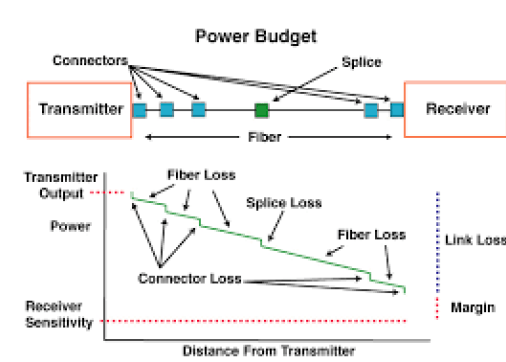For fiber-based cabling, data transmission is based on the light as the transmission medium. We know that in the transmission process, the loss of light power is inevitable. When connecting components, there will be insertion loss; when optical signals are transmitted over fiber optic cables, there will be attenuation. In addition, the material of optical components and the operation during the cabling have an influence on the amount of loss, which will determine the level of network performance. Therefore, it is necessary to reduce the loss of optical link to a minimum. This article aims to talk about loss of optical link and give some suggestions about loss control.

A complete optical link is finished by the connectivity between different fiber optical components, and no matter what kind of cabling system you are going to deploy, insertion loss is inevitable Take fiber optic connector for example, there is no perfect loss-less connector. It is important to note that even the highest quality connectors will also have insertion loss because of the alignment and the cleanliness. Structured with MT ferrule, MTP connector still has insertion loss which is rated at 0.35 dB maximum. It is impossible to ensure that fiber optic connector does not get dirty. However, dirt and dust can completely obscure the light wavelength and create huge losses.
When light travels through the core of fiber optic cable, the strength of it surely becomes lower. Naturally, the signal strength becomes weaker. This loss of light power is generally called attenuation and it locates on two aspects: internal reasons and external causes, which are also known as intrinsic fiber core attenuation and extrinsic fiber attenuation. Internal reasons of fiber optic loss are caused by the fiber optic cable itself, which is also known as intrinsic attenuation. Basically, there are two main causes of intrinsic attenuation: light absorption and scattering. As for extrinsic fiber attenuation, it is usually caused by improper handling of fiber optic cable. And there are two main types of extrinsic fiber attenuation: bend loss and splicing loss. Besides, fiber optic splicing can also result in extrinsic fiber attenuation.
For the reduction of insertion loss, it is necessary to use fiber optical components of high quality, such as for high-density cabling, MTP fiber connector is preferred.
For the purpose of reducing the intrinsic fiber core attenuation, it is necessary to select the proper fiber optics and suitable optical components for the applications, such as for short distance MTP connectivity, MPO to LC breakout cable utilizes multimode fiber OM3 or OM4; for long distance optical link, single-mode fiber is better than multimode fiber.
For reduction of extrinsic fiber attenuation, it would be better to handle the fiber optic cable properly and splice it with cautious.
Since efficient transmission of light at the operational wavelengths is the primary function of fiber optics needed for a range of applications, the loss of optical link and the potential for its minimization are of great importance in the efficient and economic use of fiber optics. It is essential to take the loss into consideration and reduce the loss to a minimum as much as possible during the cabling process.
Write a comment
zbdrariI (Monday, 19 July 2021 19:07)
20
QlqzzNwr (Sunday, 21 November 2021 10:38)
20
fnfOzvSR (Saturday, 05 March 2022 12:26)
20
fnfOzvSR (Saturday, 05 March 2022 12:28)
20
-1" OR 2+898-898-1=0+0+0+1 -- (Saturday, 05 March 2022 12:29)
20
fnfOzvSR (Saturday, 05 March 2022 12:43)
20